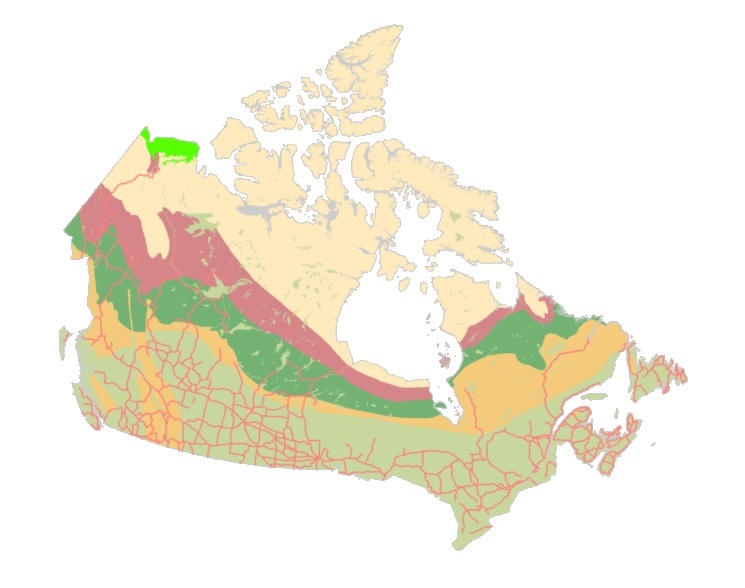Inuit
Type of resources
Available actions
Topics
Keywords
Contact for the resource
Provided by
Years
Formats
Representation types
Update frequencies
status
Service types
Scale
-

The Indigenous Mining Agreements dataset provides information on the Indigenous communities signatory to agreements, the types of agreements negotiated, exploration projects and producing mines.
-
Appendix 20. Arctic indigenous languages status and trends. Data used to compile the information for the table was collected from both census records and academic sources, each of the CAFF countries and indigenous peoples organizations (Permanent Participants to the Arctic Council) where possible also provided statistical information.
-

The Inuit Communities geographic location dataset contains the geographic location of inhabited and serviced Inuit Communities in Canada as points, as well as data attributes specific to each community. This dataset is Crown-Indigenous Relations and Northern Affairs Canada (CIRNAC) and Indigenous Services Canada (ISC) official source for Inuit Communities geographic location on maps. For more information, visit https://www.rcaanc-cirnac.gc.ca/eng/1100100014187/1534785248701.
-

The Inuit Regions, also known as the Inuit Nunangat, dataset contains the geographical boundaries of the 4 Inuit Regions in Canada: Inuvialuit, Nunavut, Nunavik and Nunatsiavut. The boundaries, land only, have been drawn as per information defined in each land claim agreement. The marine boundaries of the 4 Inuit Regions will soon be available. The Inuit Regions (Inuit Nunangat) geographical boundaries are approximate and should be used for illustration purposes only. This dataset is Crown-Indigenous Relations and Northern Affairs Canada (CIRNAC) and Indigenous Services Canada (ISC) official source for Inuit regions on maps.
-
L'indice du bien-être des collectivités (IBC) est une méthode qui permet d'évaluer le bien-être socioéconomique des collectivités canadiennes. Divers indicateurs socio-économique de bien-être soit l'éducation, l'activité, le revenu et le logement, sont dérivés à partir du recensement de la population de Statistique Canada et combinés afin de produire un 'score' de bien-être pour chaque collectivité. Ces scores sont employés pour comparer le bien-être au sein des collectivités des Premières nations et inuites au bien-être observés dans les autres collectivités canadiennes. Des valeurs pour les indicateurs peuvent être manquantes pour une collectivité en raison de la non-participation au recensement, de données dont la qualité est insuffisante ou de la taille insuffisante de la population. Pour plus de renseignements sur le sujet, visitez http://www.aadnc-aandc.gc.ca/fra/1100100016579/1100100016580.
-

The Community Well-Being (CWB) Index is a method of assessing socio-economic well-being in Canadian communities. Various indicators of socio-economic well-being, including education, labour force activity, income and housing, are derived from Statistics Canada's Census of Population and combined to give each community a well-being "score". These scores are used to compare well-being across First Nations and Inuit communities with well-being in other Canadian communities. Indicator values may be missing for a community because of non-participation in the census, inadequate data quality, or insufficient population size. For more information on the subject, visit https://www.sac-isc.gc.ca/eng/1100100016579.
-
The Community Well-Being (CWB) Index is a method of assessing socio-economic well-being in Canadian communities. Various indicators of socio-economic well-being, including education, labour force activity, income and housing, are derived from Statistics Canada's Census of Population and combined to give each community a well-being ""score"". These scores are used to compare well-being across First Nations and Inuit communities with well-being in other Canadian communities. Indicator values may be missing for a community because of non-participation in the census, inadequate data quality, or insufficient population size. For more information on the subject, visit http://www.aadnc-aandc.gc.ca/eng/1100100016579/1100100016580.
-

The "Starter Kits" of the Canadian Geospatial Data Infrastructure (CGDI) are curated bundles of geospatial data delivered as a service. These kits are the result of a user needs assessment commissioned by Natural Resources Canada (NRCan), with a primary focus on addressing the specific requirements of Indigenous Peoples. Within these kits, you'll discover a selection of data provided as a service from a collection of over 71,000 datasets falling under the "Nature and Environment" category sourced from CGDI's Federal and Provincial/Territorial partners. These Starter Kits have been thoughtfully crafted into four thematic or geographic areas of Canada: a) British Columbia, b) Northwest Territories, c) Climate Change across Canada, d) And Water Resources across Canada. Each of these kits represents diverse areas and data categories, offering new users a compact, comprehensive, and user-friendly gateway to explore a wide array of information provided by the CGDI.
-

The Indigenous Community Infrastructure dataset depicts infrastructure projects across Canada that are supported by Indigenous Services Canada (ISC) targeted infrastructure funding. It contains data related to project category, description, status, departmental investment and community. The dataset allows the Department to pinpoint and share information about individual infrastructure projects in Indigenous communities, in a proactive and transparent manner, to: • Showcase where and how investments are carried out • Demonstrate the Government’s commitment to address socio-economic gaps between Indigenous and non-Indigenous communities in Canada and improve access to high-quality services Projects featured in this Indigenous Community Infrastructure dataset are updated on a quarterly basis. Because some projects will benefit more than one community, the number of projects does not match the number of markers on the map or of entries in the dataset. For more information, visit https://www.sac-isc.gc.ca/eng/1526995988708/1526996020578.
 Arctic SDI catalogue
Arctic SDI catalogue